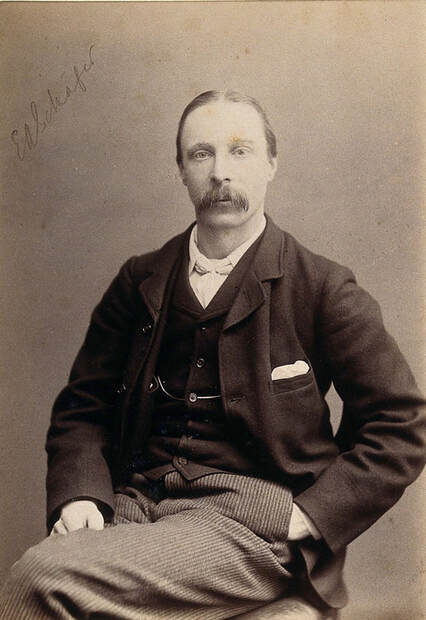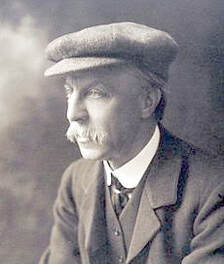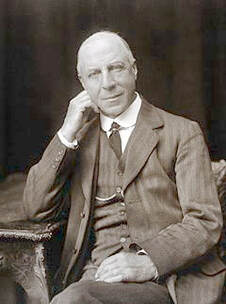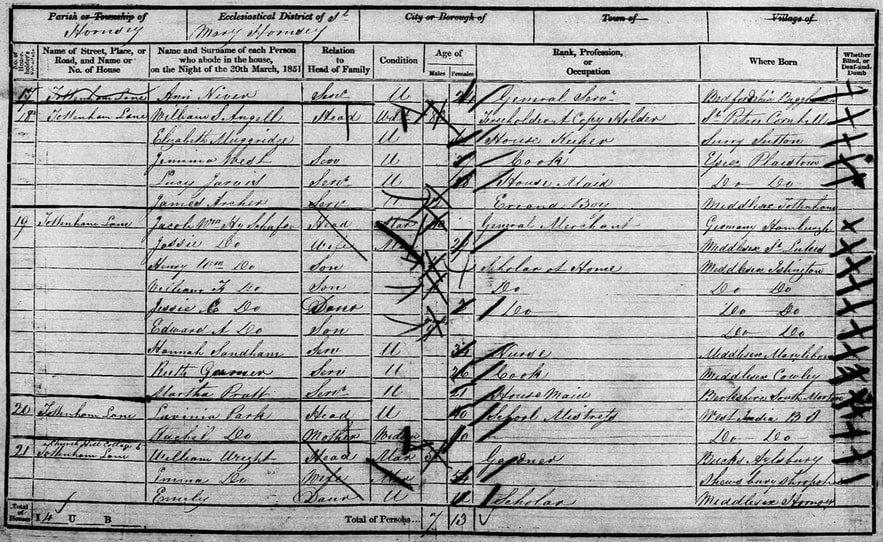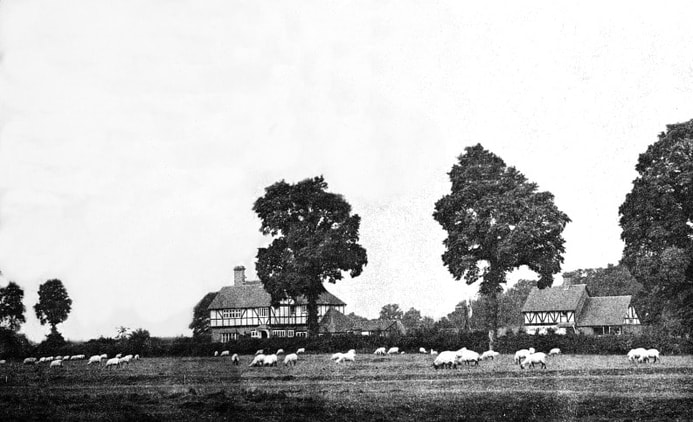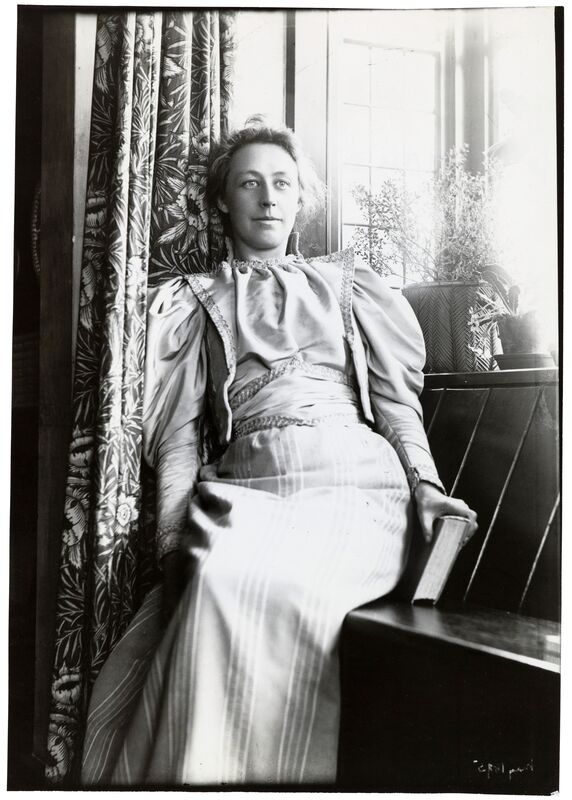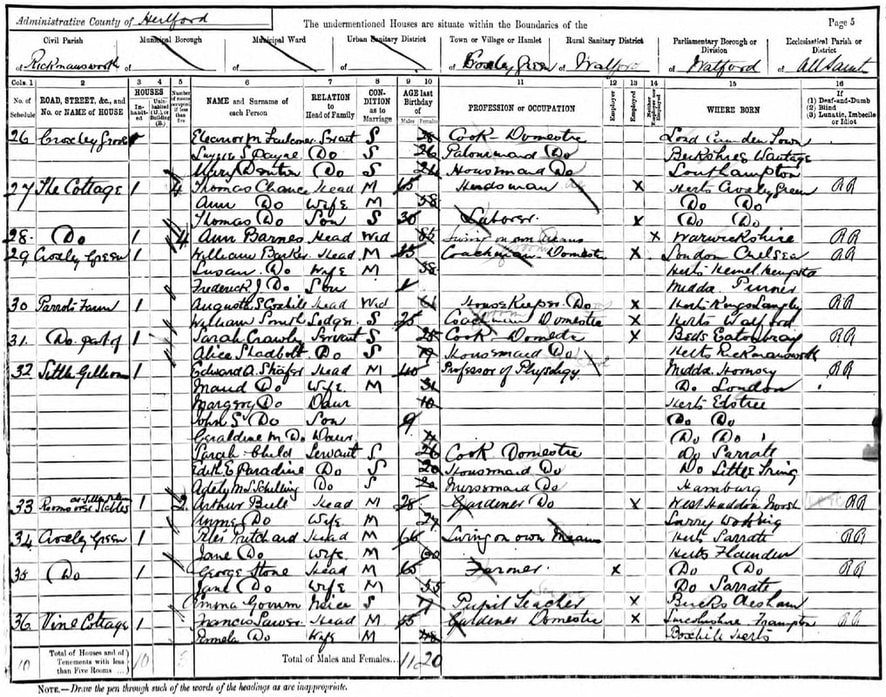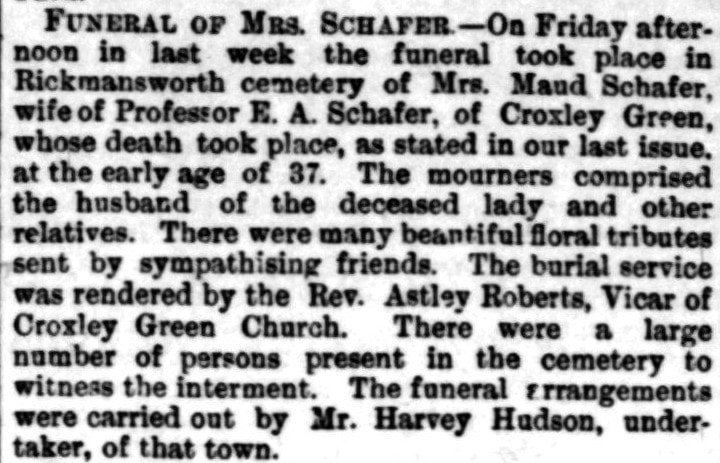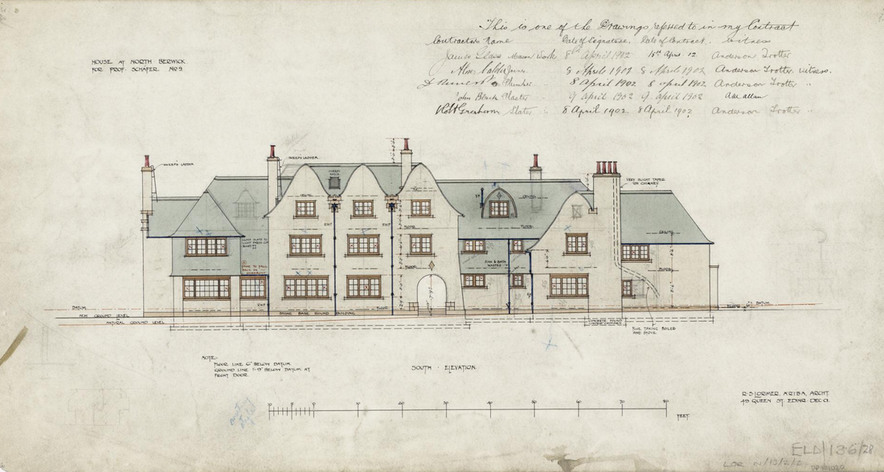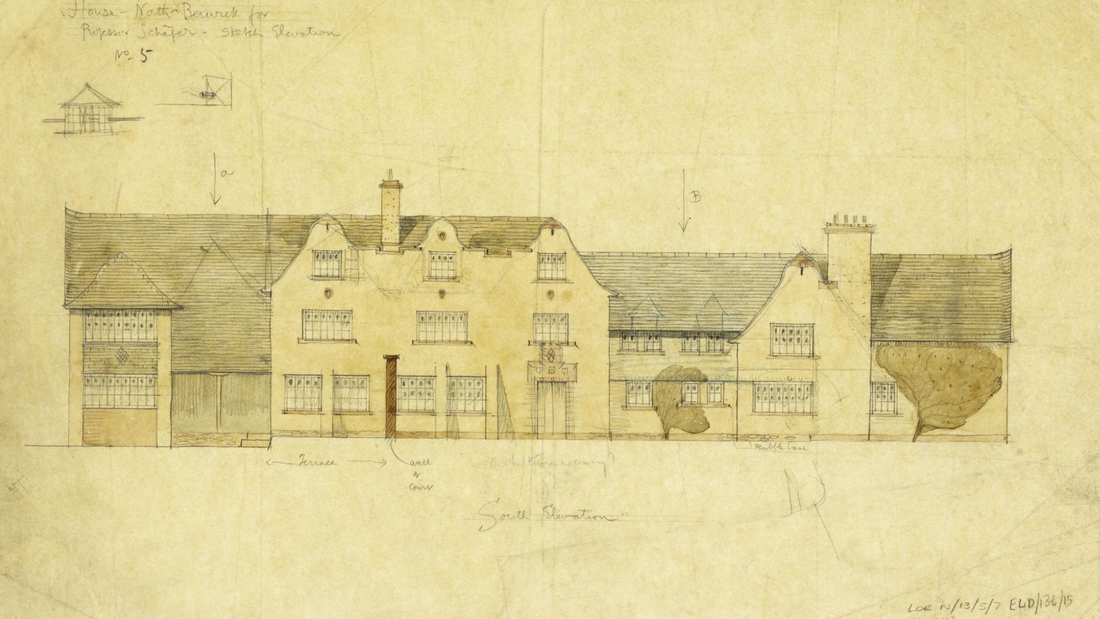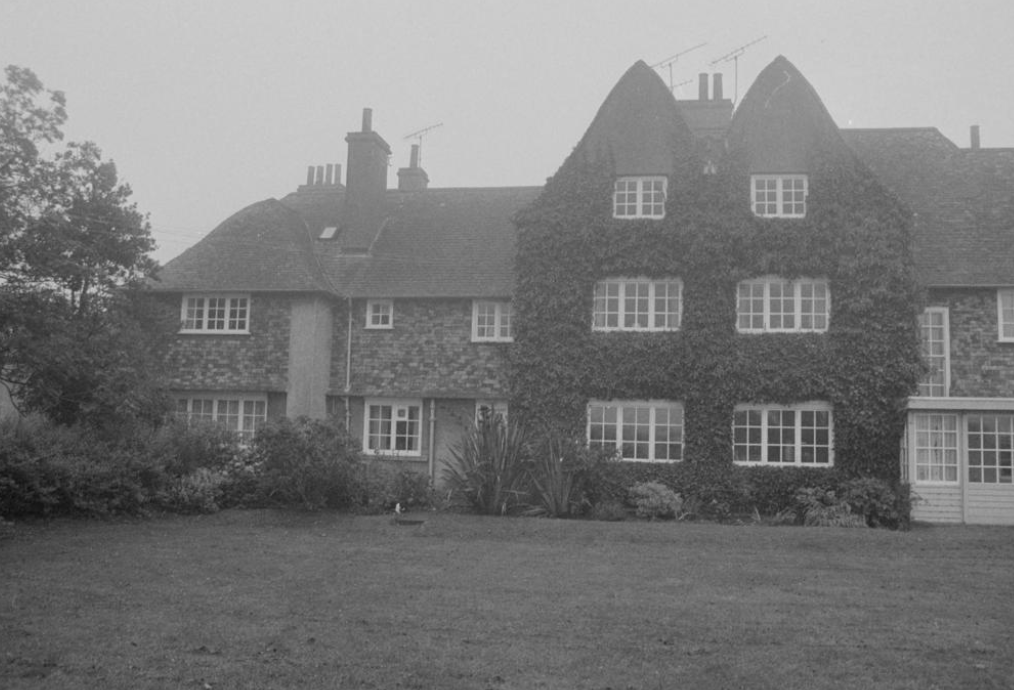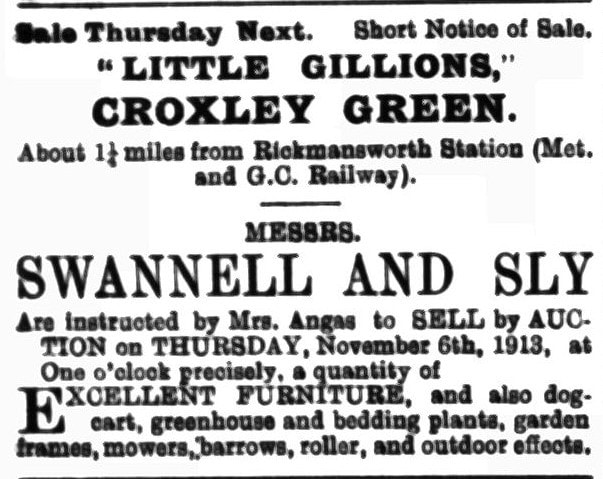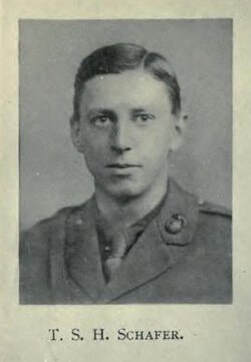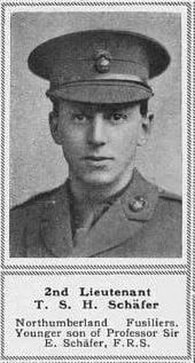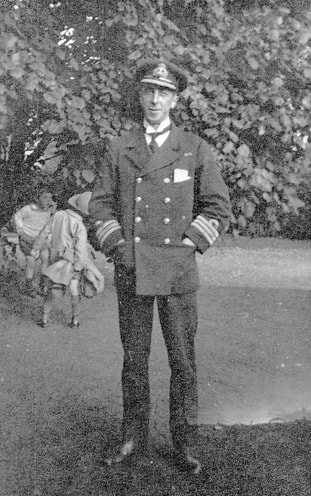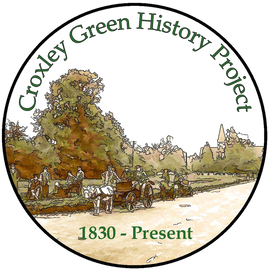Edward Albert Sharpey-Schäfer 1850 -1935
Edward Albert Schäfer lived in Little Gillions, The Green, Croxley Green.
Edward’s parents were Jacob William Henry Schäfer (1811- 1891) and Jessie Brown (1822-1892).
Jacob Schäfer married Jessie Brown on 23rd October 1844 in St Mary, Islington.
According to the 1851 census Jacob and his family were living in Tottenham Lane, Hornsey. His place of birth was given as Hamburgh, Germany and it appears he came to England as a young man and was naturalised. His occupation was shown as a Merchant. Jacob and Jessie eventually had eight children, Henry William 1846, William Frederick 1847, Jessie Caroline 1849, Edward Albert 1850, Wilhelmina Eliza 1852, Victoria Emmeline 1853, Wideria E 1854, Ernest Herbert 1860.
Jacob Schäfer married Jessie Brown on 23rd October 1844 in St Mary, Islington.
According to the 1851 census Jacob and his family were living in Tottenham Lane, Hornsey. His place of birth was given as Hamburgh, Germany and it appears he came to England as a young man and was naturalised. His occupation was shown as a Merchant. Jacob and Jessie eventually had eight children, Henry William 1846, William Frederick 1847, Jessie Caroline 1849, Edward Albert 1850, Wilhelmina Eliza 1852, Victoria Emmeline 1853, Wideria E 1854, Ernest Herbert 1860.
A notice for Bankruptcy in 1856 for Jacob and William Henry Brown (possibly a relation of his wife Jessie) at 48 Fenchurch Street, London, lists them as Dealers, Merchants and Chapmen. However, subsequent census confirms that Jacob continued as a merchant at the East India Dock, London.
Edward was educated at Clewer House School, Windsor where his brother Henry was also a pupil.
Edward was educated at Clewer House School, Windsor where his brother Henry was also a pupil.
Edward went on to study at the University College, London, in the medical school attached to the College Hospital. As a student he was interested in zoology, anatomy and in particular physiology. He gained a scholarship and excelled as a pupil of the leading Physiologist, William Sharpey. After his graduation he continued at the college pursuing his research, as well as teaching. He was appointed Assistant Professor of Practical Physiology in 1874 and was elected a Fellow of the Royal Society in 1878 when he was 28 years old.
Edward married Maud Dixey 2nd April 1878 at St Michael’s church, Highgate, Middlesex. Maud was 18 years and Edward 27 years.
Maud was born into a family with a history as optical and mathematical instrument makers. Maud’s great grandfather, Edward Dixey, took over a business at 3 New Bond Street, London, in 1824. The Dixey business flourished as family members expanded the original enterprise. Both Maud’s grandfather and father joined the business. The Dixey family soon established a wide clientele, proudly serving successive British monarchs, creating one of London's most distinguished companies, with a worldwide reputation. The firm continued at 3 New Bond Street and 19 Old Bond Street; the latter was unfortunately destroyed by bombing in the Second World War.
https://www.cwdixeyandson.com/our-story.php
Both Edward and Maud’s family lived in the same district, Highgate, and perhaps the couple met each other within the locality. It is just possible that Edward could have come to know the Dixeys through purchasing scientific instruments in their Bond Street for his research and teaching.
Following their marriage Edward and Maud lived in Oakland, Borehamwood/ Elstree, Hertfordshire, where they had four children Margaret Victoria (1879-1879) Marjory (1880-1905), John (1881-1918) and Geraldine Mary (1887).
Edward's research and teaching continued, and he gained several important appointments, including Fullerian Professor (of Chemistry) at the Royal Institution and Jodrell Professor (Zoology) at University College. His research papers were published as early as 1883 and he wrote several books to assist his students in their learning experience.
Though teaching in London, Edward and his young family came to live at Little Gillions, The Green, Croxley Green, sometime between 1887-1891. The census for the year 1891 (5th April) shows Edward aged 40, Maud aged 31, Marjory aged 10, John aged 9, and Geraldine Mary aged 4.
Edward married Maud Dixey 2nd April 1878 at St Michael’s church, Highgate, Middlesex. Maud was 18 years and Edward 27 years.
Maud was born into a family with a history as optical and mathematical instrument makers. Maud’s great grandfather, Edward Dixey, took over a business at 3 New Bond Street, London, in 1824. The Dixey business flourished as family members expanded the original enterprise. Both Maud’s grandfather and father joined the business. The Dixey family soon established a wide clientele, proudly serving successive British monarchs, creating one of London's most distinguished companies, with a worldwide reputation. The firm continued at 3 New Bond Street and 19 Old Bond Street; the latter was unfortunately destroyed by bombing in the Second World War.
https://www.cwdixeyandson.com/our-story.php
Both Edward and Maud’s family lived in the same district, Highgate, and perhaps the couple met each other within the locality. It is just possible that Edward could have come to know the Dixeys through purchasing scientific instruments in their Bond Street for his research and teaching.
Following their marriage Edward and Maud lived in Oakland, Borehamwood/ Elstree, Hertfordshire, where they had four children Margaret Victoria (1879-1879) Marjory (1880-1905), John (1881-1918) and Geraldine Mary (1887).
Edward's research and teaching continued, and he gained several important appointments, including Fullerian Professor (of Chemistry) at the Royal Institution and Jodrell Professor (Zoology) at University College. His research papers were published as early as 1883 and he wrote several books to assist his students in their learning experience.
Though teaching in London, Edward and his young family came to live at Little Gillions, The Green, Croxley Green, sometime between 1887-1891. The census for the year 1891 (5th April) shows Edward aged 40, Maud aged 31, Marjory aged 10, John aged 9, and Geraldine Mary aged 4.
After the date of the UK 1891 census, Edward and Maud travelled to Scotland, probably to confirm his acceptance of the new position he had been offered at the University of Edinburgh, but it would seem he was not yet fully committed to relocating. The Scottish census returns for 1891 show that Edward and Maud were living at 19 Coates Gardens, St Georges, Edinburgh, Midlothian, and at this address their son Thomas Sydney Herman Schäfer was born on 20th May 1891.
On the couple’s return to Little Gillions, Thomas Sydney Herman was baptised at All Saints church on 25th July 1891 by Rev Astley Roberts. Interestingly, their son’s name included a familiar German name perhaps suggesting Edward felt a link with his father’s birthplace. The family also employed a nursemaid from Hamburgh, suggesting that some contact still existed with that city.
The next few years were to become a period of sadness for both Maud and particularly Edward. His father Jacob, aged 80, who lived at 3 Alexandra Grove, North Finchley, died in 1891. His mother Jessie aged 70, died the following year in June 1892. The report of her death stated that at the time she was visiting her son and family at Little Gillions.
On the couple’s return to Little Gillions, Thomas Sydney Herman was baptised at All Saints church on 25th July 1891 by Rev Astley Roberts. Interestingly, their son’s name included a familiar German name perhaps suggesting Edward felt a link with his father’s birthplace. The family also employed a nursemaid from Hamburgh, suggesting that some contact still existed with that city.
The next few years were to become a period of sadness for both Maud and particularly Edward. His father Jacob, aged 80, who lived at 3 Alexandra Grove, North Finchley, died in 1891. His mother Jessie aged 70, died the following year in June 1892. The report of her death stated that at the time she was visiting her son and family at Little Gillions.
The following year, Maud’s father, Adolphus Dixey, died on 15th July 1893 aged 67 years at Thyra House, Thyra Grove, North Finchley.
Only three years later, another tragedy struck the family. Edward’s wife Maud died on 6th October 1896, She was just 37 years old. A service was held at All Saints church by Rev Astley Roberts and this was followed by the internment at the Chorleywood Road Cemetery. Maud’s death was widely reported and there were many relatives and friends in attendance.
Only three years later, another tragedy struck the family. Edward’s wife Maud died on 6th October 1896, She was just 37 years old. A service was held at All Saints church by Rev Astley Roberts and this was followed by the internment at the Chorleywood Road Cemetery. Maud’s death was widely reported and there were many relatives and friends in attendance.
An advertisement in the Morning Post newspaper for 15th July 1897 indicated Edward and Maud had employed a French governess living with them for 2½ years and perhaps taken over from the earlier governess from Germany.
A translation of the advertisement-:
Young French lady, available for work from the end of July, seeks post as a governess for young children or as a nursery governess; references for 2½ years; would also accept a position involving travel or abroad; teaches German grammar; speaks English and Italian quite well; good seamstress.
Miss L. C. Little Gillions, Croxley Green, Rickmansworth.
Young French lady, available for work from the end of July, seeks post as a governess for young children or as a nursery governess; references for 2½ years; would also accept a position involving travel or abroad; teaches German grammar; speaks English and Italian quite well; good seamstress.
Miss L. C. Little Gillions, Croxley Green, Rickmansworth.
The Dundee Courier for the 4th September 1897 included an article regarding Edward’s daughter Marjory and her attendance at St. Leonard’s School, St. Andrews, Fife, together with her examination results as a successful candidate for the Oxford and Cambridge schools. Her younger sister Geraldine also attended the same school.
However, Little Gillions still provided a family home after Maud's death but it would appear Edward with ongoing connections in Scotland travelled to and fro a great deal. He was appointed to the Chair of Physiology at the University of Edinburgh in 1899, and in 1900 was elected a Fellow of the Royal Society of Edinburgh.
Meanwhile events in Croxley Green brought the families of Rev. Astley Roberts, vicar of All Saints church, and Edward Schäfer into a closer relationship. Astley Roberts’ brother, John Henry, a widower since 1876, had left his home in London some time before 1900, and moved with his youngest daughter Ethel Maude, to live in Croxley Green. Probate evidence for 12th January 1900 records John Henry Roberts died at The Hawthorns, New Road, Croxley Green.
Ethel Maude Roberts and Edward Schäfer were married the same year on 10th October 1900, at St Andrews Wells Street, in the Parish of St Marylebone, London, by her uncle Rev. Astley Roberts. At the time of the marriage Ethel’s address was shown as 71 Wells Street, just of Oxford Street, London, and Edward’s address Tighnabruaich, Argyllshire.
Presumably after their marriage Edward and Ethel Maude moved to live in Scotland together with Edward’s younger children, though Little Gillions was not sold.
The Scottish census for 1901 lists Edward, Ethel Maude and Edward’s son Thomas aged 9, at school, as well as three servants residing at 19, Coates Gardens, St George, Edinburgh, West Coates, Midlothian.
The UK census for 1901 shows Edward’s eldest daughter, Marjory aged 20, as a student at Girton College, Cambridge, in lodgings in Brancaster, Norfolk.
John, aged 19, was a student at the Royal Naval Training College Greenwich, London, as a Sub-lieutenant.
Geraldine Mary was a student 14 years old at the same school that her elder sister Marjory had previously attended, St Leonards, Abbey Park, Fife, as a boarder.
In 1902 Edward commissioned the Scottish architect Robert Lorimer to design their new home, Marly Knowe, a substantial Arts and Crafts villa in the coastal town of North Berwick, East Lothian, Scotland.
It would appear Edward and Ethel had now settled and that this area would be their future home. However, for a number of years the Electoral Rolls for Croxley Green still showed Edward had Freehold property in the area, and Little Gillions was not put up for sale, but possibly let for occupation as the advertisement in August 1908
Edward’s popularity and knowledge was in demand and gave many lectures. His reputation as a teacher and his ability to impart instruction to his students, meant that the attendances at his classes often exceeded 200. For his efforts associated with artificial respiration he was awarded the Distinguished Service medal of the Royal Lifesaving Society in 1904. He is credited as the inventor of the prone-pressure method (Schafer method)
He became a founding member of the Physiological Society in 1908 and remained a member until 1933. He edited the Quarterly Journal of Experimental Physiology for some years. He travelled abroad and is known to have made a trans-Atlantic visit to New York from Glasgow, on the ‘California’ on 11th April 1908 travelling first class with Ethel.
Edward was knighted by King George V in 1913. It was sometime after receiving his knighthood that Edward added ‘Sharpey’ to his name, no doubt in tribute to the Physiologist, William Sharpey, with whom he had been a student at the U.C.L. Medical School. From that time on he was referenced in many publications etc as Edward Sharpey-Schäfer. His eldest son John also added the name Sharpey as did the other children who were referenced with the name in many articles and publications.
The same year as Edward was knighted, an advertisement appeared in the Harrow Observer, October 1913, showing Little Gillions was to be sold by auction on Thursday 6th November 1913.
He became a founding member of the Physiological Society in 1908 and remained a member until 1933. He edited the Quarterly Journal of Experimental Physiology for some years. He travelled abroad and is known to have made a trans-Atlantic visit to New York from Glasgow, on the ‘California’ on 11th April 1908 travelling first class with Ethel.
Edward was knighted by King George V in 1913. It was sometime after receiving his knighthood that Edward added ‘Sharpey’ to his name, no doubt in tribute to the Physiologist, William Sharpey, with whom he had been a student at the U.C.L. Medical School. From that time on he was referenced in many publications etc as Edward Sharpey-Schäfer. His eldest son John also added the name Sharpey as did the other children who were referenced with the name in many articles and publications.
The same year as Edward was knighted, an advertisement appeared in the Harrow Observer, October 1913, showing Little Gillions was to be sold by auction on Thursday 6th November 1913.
Edward was the recipient of many honorary degrees and prestigious medals both at home and abroad. These included the Cameron Prize for Practical Therapeutics of the University of Edinburgh, awarded by the College of Medicine and Veterinary Medicine to a person who had, over a five-year period, made highly important and valuable additions to the application of remedies to diseases.
Edward continued to write many papers and books, one particular book for students on the Essentials of Histology, the microscopic structure of tissue, ran into sixteen editions between 1885 and 1954.
In spite of such a busy life Edward still found time to be introduced to playing Golf and no doubt was delighted that there were so many elite golf courses nearby his home.
However, in spite of his academic success, tragedy still occurred in his personal life
His daughter Marjory died aged only 24 in 1905, the death registered in Holborn, London.
When Great Britain declared war with Germany on 4th August 1914, Edward’s sons John and Thomas Sydney Herman were among the many thousands of young men who lost their lives in the conflict of World War One.
Thomas enlisted as soon as the war began and was promoted as Lieutenant in the 13th Northumberland Fusiliers. He was killed in France on the 26th September 1915.
Edward continued to write many papers and books, one particular book for students on the Essentials of Histology, the microscopic structure of tissue, ran into sixteen editions between 1885 and 1954.
In spite of such a busy life Edward still found time to be introduced to playing Golf and no doubt was delighted that there were so many elite golf courses nearby his home.
However, in spite of his academic success, tragedy still occurred in his personal life
His daughter Marjory died aged only 24 in 1905, the death registered in Holborn, London.
When Great Britain declared war with Germany on 4th August 1914, Edward’s sons John and Thomas Sydney Herman were among the many thousands of young men who lost their lives in the conflict of World War One.
Thomas enlisted as soon as the war began and was promoted as Lieutenant in the 13th Northumberland Fusiliers. He was killed in France on the 26th September 1915.
John had retired from his original career in the Navy but now with the outbreak of war rejoined as Commander John Sharpey-Schäfer. Whilst on board the H.M.S. "Gaillardia." in the North Sea his ship struck a mine and exploded. He died on 22 March 1918 age 36 years old.
Edward and Ethel continued to live in North Berwick attending many informal as well as formal functions as Sir Edward and Lady Sharpey-Schäfer.
Edward received a great many more academic distinctions from British and foreign universities and learned bodies. In 1923 he was president of the International Physiological Conference, travelling abroad to give lectures as well as attending conferences.
Edward died at his home in North Berwick on 29 March 1935. He was cremated at Edinburgh Crematorium, but his ashes were interred at the Chorleywood Cemetery, Rickmansworth. It is clear he still felt some sort of connection with Croxley Green, even after so many years away, especially as his first wife Maud was buried here.
Ethel died on the 2nd December 1942 at the home of her step-daughter Geraldine Mary Sharpey-Schäfer, a Hampshire County Council Local Government Officer, Little Chilland, Martyr Worthy, near Winchester, Hampshire.
Geraldine died on the 21st December 1979, when she was 92 years old.
In 1939 at the onset of WW2, the Royal Life Saving Institiute issued a pamphlet detailing the correct instructions for those coaching for the Air Raid Precautions (ARP), and was taken from the original document written in 1931 that Edward had recommended. 50,000 copies were printed and distributed to the ARP Officers, Clerks to local councils,and the Police and Fire Services.
Information taken from to following-:
https://wellcomecollection.org/search?query=edward+albert+schafer
www.findmypast.co.uk/Family/History
https://www.findmypast.co.uk/search-newspapers
https://www.ancestry.com/
https://www.britannica.com/biography/Edward-Albert-Sharpey-Schafer
https://royalsocietypublishing.org/doi/10.1098/rsbm.1935.0005
Edward received a great many more academic distinctions from British and foreign universities and learned bodies. In 1923 he was president of the International Physiological Conference, travelling abroad to give lectures as well as attending conferences.
Edward died at his home in North Berwick on 29 March 1935. He was cremated at Edinburgh Crematorium, but his ashes were interred at the Chorleywood Cemetery, Rickmansworth. It is clear he still felt some sort of connection with Croxley Green, even after so many years away, especially as his first wife Maud was buried here.
Ethel died on the 2nd December 1942 at the home of her step-daughter Geraldine Mary Sharpey-Schäfer, a Hampshire County Council Local Government Officer, Little Chilland, Martyr Worthy, near Winchester, Hampshire.
Geraldine died on the 21st December 1979, when she was 92 years old.
In 1939 at the onset of WW2, the Royal Life Saving Institiute issued a pamphlet detailing the correct instructions for those coaching for the Air Raid Precautions (ARP), and was taken from the original document written in 1931 that Edward had recommended. 50,000 copies were printed and distributed to the ARP Officers, Clerks to local councils,and the Police and Fire Services.
Information taken from to following-:
https://wellcomecollection.org/search?query=edward+albert+schafer
www.findmypast.co.uk/Family/History
https://www.findmypast.co.uk/search-newspapers
https://www.ancestry.com/
https://www.britannica.com/biography/Edward-Albert-Sharpey-Schafer
https://royalsocietypublishing.org/doi/10.1098/rsbm.1935.0005
